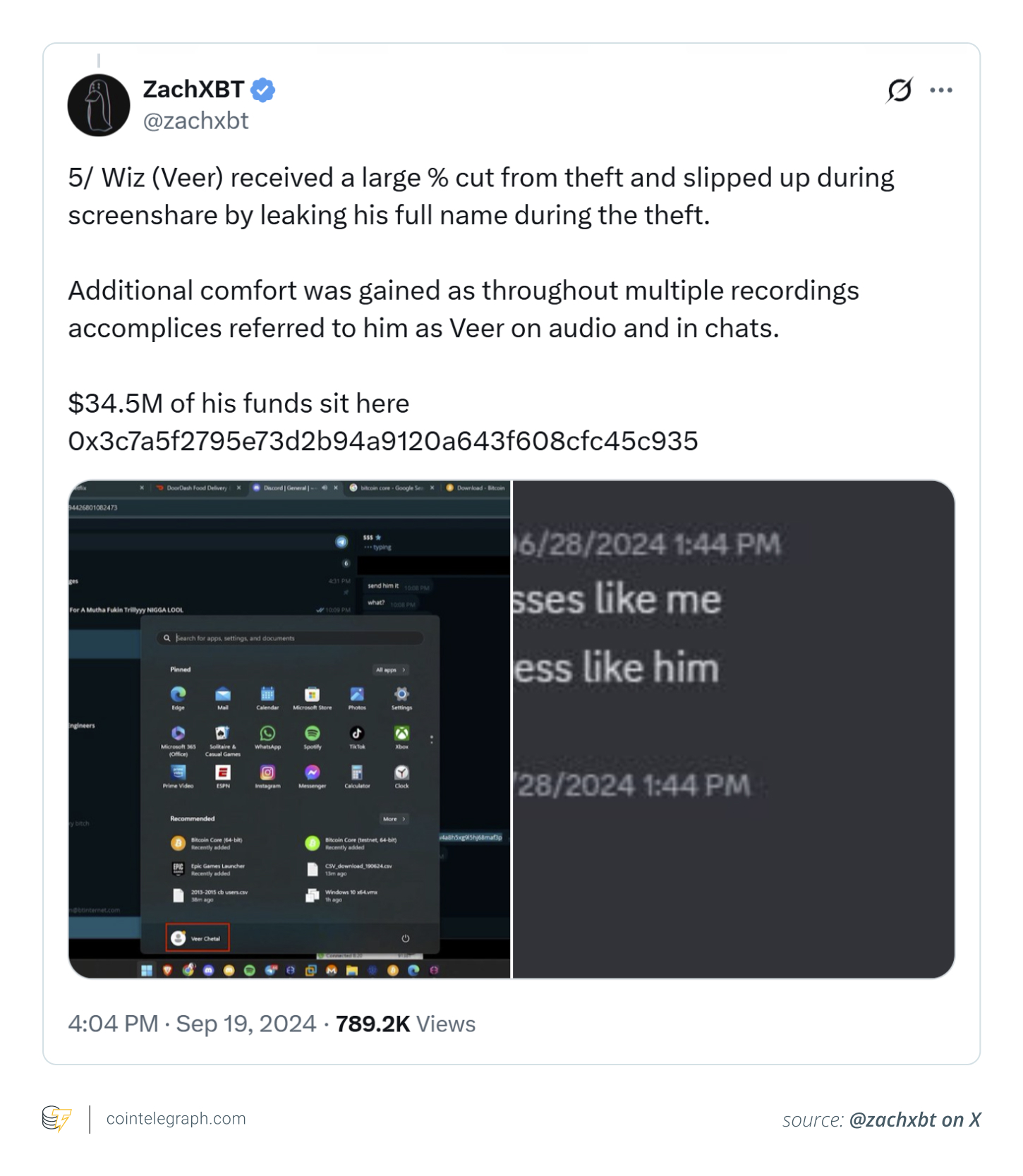$243M Bitcoin scam that led to kidnapping and chaos
In one of the most bizarre crossovers between digital crime and real-world violence, a group of young cybercriminals stole almost $243 million in Bitcoin (BTC). Within weeks, the fallout spilled from the blockchain into a quiet Connecticut suburb, ending in a harrowing kidnapping plot.
If this seems like the plot of a Netflix thriller, you’re not alone in thinking that. But it happened. And fast.
Let’s unpack how a Minecraft-playing teenager, an underground network of crypto thieves and a Lamborghini-driving suburban couple all became tangled in a wild web of digital deception and real-world chaos.
It all started when a Washington, D.C.-based cryptocurrency investor received a suspicious phone call. The person on the other end posed as a security representative from Google. A second call came from someone claiming to be with Gemini, a well-known crypto exchange.

What followed was a textbook case of social engineering. The scammers convinced the victim to download software that gave them remote access to his computer. Moments later, 4,100 Bitcoin worth $243 million at the time vanished from his wallets.
And that’s when things really got weird.
How crypto detectives unmasked the thieves behind the $243M heist
The crypto world may seem like the Wild West, but it has its sheriffs. One of them is ZachXBT, a pseudonymous investigator revered for his blockchain detective work.
ZachXBT was walking through an airport when he got an alert about suspicious transactions. By the time he was in the air, he’d already traced the stolen funds to a mysterious wallet.
Within hours, he and a team of independent investigators started tracking the money across dozens of exchanges, even notifying the platforms to freeze the assets.
But the real breakthrough? A video.
A source anonymously sent ZachXBT screen recordings of the thieves celebrating the heist, cheering over Discord and flashing millions on-screen. One of them accidentally revealed his real name: Veer Chetal, an 18-year-old honor student from Danbury, Connecticut.

Yes, the same Danbury where the kidnapping took place.

Did you know? In January 2025, Ledger co-founder David Balland was kidnapped in France and later safely released following a police intervention. The abduction was linked to a cryptocurrency ransom demand, highlighting the growing intersection of digital assets and real-world crime.
Real-world consequences: The kidnapping of Veer’s parents
Just one week after the digital heist, Sushil and Radhika Chetal (Veer’s parents) were house-hunting in their $240,000 Lamborghini Urus when two vehicles ambushed them. Authorities have described Veer’s parents solely as victims of the kidnapping, with no indication they were involved in the crypto theft.
Reportedly, armed attackers dragged the couple into a van, bound them with duct tape and fled the scene. Thankfully, quick-thinking bystanders (including an off-duty FBI agent) helped police track the van. The Chetals were rescued, and four of the six suspects were caught within hours.
But why target the parents?
It turned out the motive was chilling: Veer’s co-conspirators wanted to extort him. They knew he was involved in the crypto theft. Now, they viewed his parents as leverage to force him to share the loot — or more of it.
From Minecraft to multimillion-dollar crime
Veer Chetal wasn’t just some teenager with a knack for crypto. He was allegedly part of “the Com,” an underground online collective that evolved from Minecraft servers and video game scams into a sophisticated criminal network involved in everything from SIM swapping to crypto fraud.
His path from honor student to alleged cybercriminal seems to have accelerated fast. Classmates noticed him suddenly showing up to school in a Corvette, then a BMW, then a Lamborghini. He threw parties on yachts and wore luxury brands that most teens have only seen in rap videos.
His digital partner in crime? Malone Lam, a Singaporean hacker known in online circles as “Greavys” and “Anne Hathaway.” After the heist, Lam blew through millions on nightclubs, cars and champagne in Los Angeles and Miami, even trolling ZachXBT online by holding up signs mocking him in clubs.

The collapse: Arrests, raids and guilty pleas
The lavish lifestyle didn’t last long. The FBI, aided by crypto investigators, tracked Lam, Veer and others across states and continents.
Here’s what happened:
- Lam was arrested in Miami after a SWAT-style raid on a mansion he’d rented.
- Another suspect was caught at LAX wearing a $500,000 watch.
- Veer was quietly arrested, too, the son of the kidnapped couple, and is now facing federal charges.
By March 2025, five out of six of the Florida-based kidnappers had pleaded guilty. They face up to 15 years in prison. Others involved in the digital theft are still under investigation, and a federal wallet now holds the recovered Bitcoin.
Did you know? Despite using sophisticated laundering methods, one co-conspirator failed to use a VPN, exposing his location through an IP address tied to a high-end rental. Authorities traced him to Jeandiel Serrano, aka VersaceGod, who was enjoying a vacation in the Maldives by the time they caught up with him.
The growing link between digital crime and real-world consequences
What’s frightening is how seamlessly this crime flowed from the digital world into the physical.
As cybersecurity expert Allison Nixon put it: “We are seeing an evolution from disorganized crime to organized crime, and we are somewhere in the middle point of that.”
Groups like the Com are no longer just pranksters or hackers; they’re hardened, organized, and increasingly violent. They share success stories and flaunt wealth, recruiting the next generation through Discord, Telegram and Minecraft.
The $243 million crypto heist that led to a real-world kidnapping is more than just a headline. It’s a warning. It shows how cybercrime no longer stays online, and how youthful arrogance, digital anonymity and unchecked greed can have very real-world consequences.
And as fast as this group got rich, they got caught even faster.
Ultimately, not even Lamborghinis and champagne could protect them from the blockchain breadcrumbs they left behind.
The dark side of crypto and the need for vigilance
While cryptocurrency offers many advantages, it also has a darker side that cannot be ignored. The very features that make crypto attractive — decentralization, anonymity and ease of transfer — are also what make it a breeding ground for illegal activities.
From money laundering and fraud to scams and cybercrime, crypto has become a tool for a wide range of criminals. The lure of quick profits and easy money, combined with the anonymity of digital currencies, makes crypto especially appealing to young, impressionable individuals.
Many are introduced to it through seemingly harmless channels, such as online gaming or social media, where they may encounter cybercriminals looking to recruit the next generation of offenders. This makes it all the more important for parents and guardians to stay aware of their child’s digital activities and online behavior.
Cryptocurrency is not inherently dangerous, but it can open the door to hazardous paths if misused. For those new to the space, it’s crucial to understand the risks involved. Scammers can use sophisticated techniques to deceive and steal, and the lack of regulation can leave victims without recourse.
As crypto continues to grow in popularity, the potential for cybercrime will likely expand, and the consequences of digital theft could become more severe and tangible.
Keeping an eye on your child’s digital activity
With the rise of cryptocurrencies, it’s essential for parents to educate their children about the risks associated with digital assets.
- Keeping an eye on their online interactions, including the apps, games and forums they frequent, is critical in ensuring they don’t fall prey to digital criminals.
- Encouraging open conversations about internet safety, teaching them about the dangers of sharing personal information online and monitoring their digital wallets are simple yet effective ways to protect them from the darker side of crypto.
As the boundaries between the digital world and real-world consequences continue to blur, it’s important to stay vigilant. Whether it’s ensuring your child’s safety in the digital space or understanding the broader risks posed by crypto, being proactive can help navigate the ever-evolving landscape of digital finance. By taking precautions and staying informed, you can harness the benefits of cryptocurrency while minimizing its dangers.





